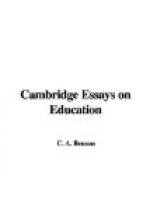From one point of view, all the old universities of Europe—Bologna, Paris, Prague, Oxford, Cambridge, etc.—must be regarded as definite and conscious protests against the dividing and isolating—the anti-civic—forces of the periods of their institution. They represent historically the development of communities for common interest and protection in the great and holy cause of the pursuit of learning, and above all things their story is the story of the growth of European unity and citizenship.
The feudal and ecclesiastical order of the old mediaeval world were both alike threatened by the power that had so strangely sprung up in the midst of them. Feudalism rested on local isolation, on the severance of kingdom from kingdom and barony from barony, on the distinction of blood and race, on the supremacy of material or brute force, on an allegiance determined by accidents of place and social position. The University, on the other hand, was a protest against this isolation of man from man. The smallest school was European and not local[3].
The spirit which is characteristic of a university in its best aspects, linked with the spirit which is inherent in the ranks of working people, has on more occasions than one set on foot movements for the education of the people. One of the most notable instances of this unity found expression at the Oxford Co-operative Congress of 1882, when Arnold Toynbee urged co-operators to undertake the education of the citizen. By this he meant: “the education of each member of the community as regards the relation in which he stands to other individual citizens and to the community as a whole.” “We have abandoned,” he said further, “and rightly abandoned the attempt to realise citizenship by separating ourselves from society. We will never abandon the belief that it has yet to be won amid the stress and confusion of the ordinary world in which we move.” From that day to this co-operators have always had before them an ideal of education in citizenship and have organised definite teaching year by year.




